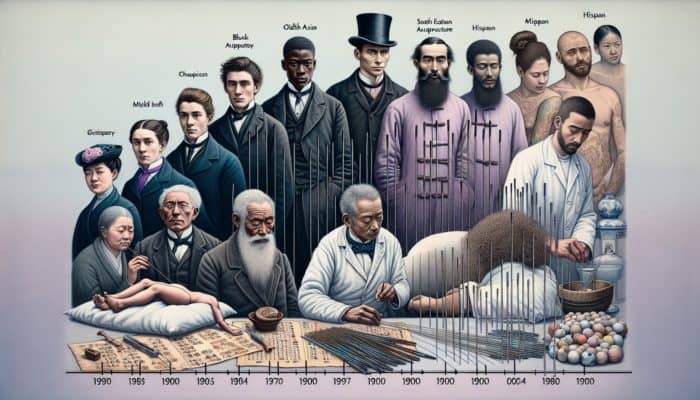Comprehensive Guide to Acupuncture Techniques for Relieving Joint Stiffness in the UK
Acupuncture, a cornerstone of traditional Chinese medicine, has become increasingly embedded within the UK healthcare system, especially for addressing ailments such as joint stiffness. With a rich history spanning over 200 years, this revered practice has evolved to meet modern clinical demands and patient expectations. Today, acupuncture is recognised not just as a complementary therapy but as a vital component of holistic health treatment, offering significant benefits to those grappling with joint stiffness and associated health issues.
Tracing the Historical Journey of Acupuncture's Adoption in Britain

The origins of acupuncture in Britain can be traced back to the early 19th century when British expatriates returning from China shared insights into this ancient healing method. Initially met with considerable skepticism, acupuncture gradually garnered acceptance as more practitioners began to acknowledge its remarkable effectiveness in treating various ailments. By the mid-20th century, acupuncture had gained formal recognition, leading to the establishment of accredited acupuncture schools across the UK. As scientific studies unfolded, showcasing its benefits, particularly for conditions like joint stiffness, acupuncture transitioned from niche clinics into mainstream healthcare offerings.
The integration of acupuncture into the UK medical framework was not without its challenges. Early practitioners faced regulatory hurdles and a notable absence of formal training pathways. However, as evidence supporting the efficacy of acupuncture accumulated, so did the establishment of regulatory bodies such as the British Acupuncture Council (BAcC). These organisations uphold stringent standards of safety and efficacy, thereby enhancing public trust in acupuncture as a credible treatment option for a variety of health concerns.
Understanding the Regulatory Frameworks and Professional Standards Governing Acupuncture
The regulation of acupuncture practices in the UK is primarily managed by the British Acupuncture Council. This body sets rigorous standards for training and practice, ensuring that acupuncturists are adequately qualified to treat patients experiencing various conditions, including joint stiffness, which acupuncture can effectively alleviate. The BAcC plays a crucial role in maintaining professional integrity, offering patients reassurance regarding the safety and efficacy of acupuncture treatments.
Acupuncturists are required to undergo extensive training, covering anatomy, physiology, and practical clinical experience, often culminating in a degree or diploma recognised by the BAcC. This thorough educational pathway equips practitioners with vital skills to conduct comprehensive patient assessments and devise tailored treatment plans aimed at alleviating joint stiffness and related ailments. Furthermore, the BAcC advocates for continuous professional development, ensuring practitioners remain informed about the latest research and innovative techniques in the field.
Enhancing Accessibility to Acupuncture Services Throughout the UK
Acupuncture services are increasingly accessible across the UK, with a rising number of clinics dedicated to alleviating joint stiffness. Major urban centres like London, Manchester, and Bristol boast a multitude of acupuncture clinics, providing patients with convenient options for seeking treatment. Additionally, many practitioners offer home visits, significantly improving accessibility for individuals facing mobility challenges or residing in remote areas.
Beyond private clinics, some NHS trusts have begun to acknowledge the therapeutic benefits of acupuncture, offering services to patients dealing with chronic conditions. This recognition is particularly significant for individuals looking for alternatives to pharmaceutical interventions for joint stiffness. Patients can often find acupuncturists within physiotherapy units, pain management clinics, and even general practices, showcasing a comprehensive healthcare model that harmonises traditional and modern therapeutic approaches.
Thorough Training and Qualifications for Aspiring Acupuncturists

Becoming a certified acupuncturist in the UK involves a demanding process, typically requiring three to four years of study at accredited institutions. Aspiring practitioners not only learn acupuncture techniques but also delve deeply into the foundational principles of traditional Chinese medicine, including the philosophy of Qi (energy flow) and the body's meridians. This educational experience is complemented by extensive clinical placements, enabling graduates to acquire practical experience in treating a diverse range of conditions, including acupuncture for joint stiffness.
Moreover, practitioners are encouraged to pursue additional certifications and specialisations. Some may choose to focus on specific populations, such as elderly patients or athletes, refining their expertise to address particular issues related to joint stiffness. This dedication to advanced training ensures that patients can locate acupuncturists who are not only qualified but also equipped to deliver effective, personalised treatments tailored to their unique needs.
Shifting Public Perception and Acceptance of Acupuncture
Over recent decades, public perception of acupuncture in the UK has undergone a remarkable transformation. Once met with doubt, many patients now view acupuncture as a credible alternative treatment for a range of ailments, including joint stiffness. The combination of positive patient testimonials and an expanding body of scientific research supporting acupuncture's effectiveness has significantly bolstered its acceptance within the healthcare community.
Surveys indicate a noticeable rise in individuals seeking acupuncture treatments, with many reporting significant improvements in their joint stiffness and overall well-being. This trend is not merely anecdotal; studies have demonstrated that acupuncture can alleviate pain, enhance functionality, and elevate the quality of life for individuals suffering from chronic joint conditions. As awareness continues to grow, acupuncture is solidifying its position within both private and NHS healthcare systems throughout the UK.
Exceptional Advantages of Acupuncture in Alleviating Joint Stiffness
The advantages of considering acupuncture as a treatment for joint stiffness are profound and varied. Numerous patients share transformative experiences after acupuncture sessions, highlighting its potential to diminish pain and enhance mobility. This ancient practice extends beyond the simple act of needle insertion; it embodies a holistic approach that addresses the root causes of stiffness while promoting overall health and wellness.
Substantial Pain Relief Achievable Through Acupuncture Techniques

One of the most compelling benefits of acupuncture for joint stiffness lies in its remarkable capacity to significantly alleviate pain. Research indicates that acupuncture triggers the release of endogenous endorphins, the body's natural pain-relieving compounds. Patients often report rapid pain relief following treatment, a transformation that can be life-changing for those who have endured chronic discomfort over extended periods.
In addition, acupuncture's targeted stimulation of specific acupuncture points can directly affect pain pathways, aiding in the modulation of the body's pain response. For individuals in the UK suffering from joint stiffness resultant from conditions such as arthritis or tendonitis, acupuncture presents a non-invasive alternative with minimal side effects compared to traditional pain relief medications.
Beyond immediate pain relief, consistent acupuncture treatments frequently lead to long-lasting reductions in discomfort. A significant number of patients discover that their reliance on analgesics diminishes, allowing them to engage more actively in daily activities, from walking to exercising. This enhancement in quality of life is invaluable, particularly for those who may have felt restricted by their condition.
Boosting Mobility with Acupuncture Treatments
Patients undergoing acupuncture for joint stiffness regularly report improvements in mobility and flexibility. The treatment promotes enhanced blood circulation while simultaneously reducing inflammation around the joints, which can hinder movement. This dual effect enables individuals to experience newfound freedom in their movements, a crucial aspect of maintaining an active lifestyle.
Acupuncture sessions typically involve the careful stimulation of points associated with the joints and muscles, encouraging the body to release tightness and tension. For individuals in the UK who have faced limitations due to joint stiffness, this increased mobility can pave the way for a more active and fulfilling life. Activities that may have previously seemed daunting, such as ascending stairs or participating in sports, become achievable, fostering a renewed sense of independence and well-being.
Furthermore, enhanced mobility resulting from acupuncture contributes to overall physical health. Increased movement promotes improved joint function, muscle strength, and even psychological benefits as patients engage in social activities and exercise regimens. This holistic approach to treatment ensures that patients not only witness physical enhancements but also enjoy improved emotional well-being.
Attaining Sustainable Relief from Joint Stiffness
The quest for enduring relief from joint stiffness is a common concern for many individuals, particularly those grappling with chronic conditions. Acupuncture stands out as a viable choice, promoting long-lasting outcomes rather than temporary solutions. Regular treatments can yield sustained relief from stiffness and pain, thereby reducing the necessity for ongoing medication.
Research indicates that patients who commit to a series of acupuncture sessions often experience cumulative benefits, with enhancements building progressively over time. This approach sharply contrasts with conventional treatments, which may provide fleeting relief but frequently result in dependency on painkillers or anti-inflammatory medications. Acupuncture encourages the body’s self-healing capabilities, addressing the underlying issues rather than merely masking symptoms.
As patients achieve long-term relief, they may rediscover confidence in movement and physical activity. This not only improves their quality of life but also encourages healthier lifestyle choices, creating a positive feedback loop of wellness. Embracing acupuncture can thus transform the journey towards holistic health, liberating individuals from the constraints of joint stiffness and associated challenges.
Effectively Mitigating Inflammation Through Acupuncture
Inflammation plays a pivotal role in joint stiffness and pain, often exacerbating conditions such as rheumatoid arthritis and osteoarthritis. Acupuncture serves as a potent tool for alleviating inflammation, thereby facilitating improved joint function overall. This practice activates the body's innate healing mechanisms, enhancing the release of anti-inflammatory substances.
Clinical studies have underscored acupuncture's effectiveness in lowering inflammation markers, with patients often reporting decreased swelling and tenderness around affected joints. This advantage is crucial for individuals suffering from chronic inflammatory conditions, as reduced inflammation equates to improved mobility and comfort.
Moreover, acupuncture aids in regulating the immune system, balancing its response and preventing overactive inflammation that can lead to joint deterioration. By addressing the fundamental causes of inflammation, acupuncture for joint stiffness empowers patients to reclaim control over their health and recovery journey.
Additionally, acupuncture sessions can be tailored to target specific areas of inflammation, ensuring that treatment is both effective and personalised to individual needs. This customised approach not only enhances the efficacy of the treatment but also fosters a deeper understanding of one’s body and health, encouraging patients to engage actively in their recovery process.
Diverse Acupuncture Styles Practised Across the UK
Acupuncture in the UK encompasses a wide range of styles and techniques, each offering distinct methods for treating conditions such as joint stiffness. Understanding these various modalities empowers patients to select the most suitable treatment, tailored to their individual needs.
Traditional Chinese Acupuncture: Embracing a Holistic Healing Philosophy
Traditional Chinese Acupuncture (TCA) is deeply entrenched in ancient practices, concentrating on the flow of Qi (energy) through the body's meridians. By targeting specific acupuncture points, TCA aims to restore balance and alleviate symptoms, including joint stiffness. This method is particularly beneficial for those seeking a holistic approach to their well-being, as it addresses not only physical symptoms but also emotional and mental health.
Practitioners of TCA dedicate years to mastering the intricate pathways of the body's energy systems, employing fine needles to stimulate key points associated with various organs and systems, thereby promoting overall bodily harmony. For patients contending with joint stiffness, TCA can effectively alleviate pain while enhancing mobility and reducing inflammation, culminating in a comprehensive healing experience.
In the UK, numerous practitioners incorporate TCA principles into their treatment plans, customising sessions to address each patient's unique symptoms and health history. This personalised strategy guarantees that individuals suffering from joint stiffness receive the most effective care possible, blending ancient wisdom with contemporary understanding and techniques.
Western Medical Acupuncture: An Evidence-Based Approach
Western Medical Acupuncture adopts a more scientific perspective, focusing on anatomical and physiological principles. This method utilises evidence-based practices and often targets specific trigger points linked to pain. For patients experiencing joint stiffness, Western Medical Acupuncture can be particularly efficacious, as it directly addresses the underlying causes of discomfort.
Practitioners trained in Western Medical Acupuncture frequently possess backgrounds in fields such as physiotherapy or medicine, equipping them with a robust understanding of human anatomy. This expertise allows them to apply acupuncture alongside other therapeutic techniques, maximising benefits for patients dealing with joint stiffness and related conditions.
As ongoing research continues to affirm the effectiveness of this approach, an increasing number of healthcare providers in the UK are incorporating Western Medical Acupuncture into their practices. Patients can benefit from a comprehensive treatment plan that integrates acupuncture with other modalities, optimising outcomes for conditions such as joint stiffness while enhancing overall health.
Electroacupuncture: A Contemporary Therapeutic Advancement
Electroacupuncture introduces a modern enhancement to traditional methods by employing mild electrical currents to amplify the effects of needle insertion. This technique is particularly effective for conditions such as joint stiffness, as electrical stimulation can promote greater muscle relaxation and pain relief.
In clinical settings throughout the UK, electroacupuncture has gained traction among practitioners for its ability to provide rapid and effective results. The electrical pulses stimulate acupuncture points more intensively than manual needling alone, leading to enhanced circulation and reduced inflammation in targeted areas.
Patients often find electroacupuncture sessions to be effective and comfortable. By promoting better joint healing, this technique can significantly alleviate stiffness, enabling individuals to regain their mobility and improve their overall quality of life. For those in search of innovative solutions for chronic joint issues, electroacupuncture presents a promising option worth considering.
Essential Tips for Choosing the Right Acupuncturist in the UK
Selecting the ideal acupuncturist for joint stiffness treatment is vital, especially for those seeking relief. With the growing popularity of acupuncture, understanding what to look for can empower patients to make informed choices.
Crucial Qualifications to Look for in a Qualified Acupuncturist
When searching for an acupuncturist in the UK, it is imperative to ensure they are registered with the British Acupuncture Council (BAcC). This registration signifies that the practitioner has met stringent training and ethical standards, confirming their qualifications to treat conditions such as acupuncture for joint stiffness.
Alongside BAcC registration, consider the practitioner's experience and area of expertise. Some acupuncturists may specialise in managing chronic pain or joint conditions, which can be particularly advantageous for patients seeking targeted care. A practitioner with a proven history of addressing similar issues can offer valuable insights and strategies tailored to individual needs.
Furthermore, it is beneficial to inquire about their commitment to continuing education. Acupuncture is a dynamic field, and practitioners who engage in ongoing learning are often better prepared to integrate the latest research and techniques into their practice, ensuring the highest quality of care.
Utilising Patient Feedback and Testimonials for Informed Decision-Making
Patient reviews and testimonials can offer valuable insights into an acupuncturist's effectiveness in treating joint stiffness. Many clinics now feature feedback from previous clients, showcasing their experiences and outcomes. When evaluating a practitioner, take the time to read through these reviews, focusing on comments regarding treatment effectiveness, the practitioner's professionalism, and overall patient satisfaction.
Moreover, word-of-mouth recommendations can be incredibly impactful. Friends, family, or local support groups may share personal experiences that can guide your choice. Engaging in conversations about acupuncture can lead you to practitioners known for their successful treatment of joint stiffness and related conditions.
Additionally, online platforms frequently allow patients to share detailed accounts of their treatment journeys. This transparency helps you assess whether a specific acupuncturist aligns with your expectations and needs, ensuring that you make a well-informed decision.
Accessibility and Location Factors When Selecting an Acupuncturist
Accessibility is a key consideration when choosing an acupuncturist, particularly for those who require regular treatments for joint stiffness. Seek clinics that are conveniently located, whether in a bustling city centre or a peaceful suburban area. Many practitioners also offer flexible hours to accommodate the diverse schedules of their patients.
It is essential to evaluate the physical accessibility of the clinic. For individuals with mobility challenges, confirming that the premises are wheelchair-friendly and easy to navigate can significantly enhance the treatment experience. Some practitioners may even provide home visits, offering a convenient option for those who prefer to receive treatment in the comfort of their own homes.
Furthermore, the availability of parking or proximity to public transport can affect your decision. Finding a clinic that is easily reachable contributes to a smoother treatment experience, encouraging regular attendance and adherence to your acupuncture plan.
Understanding Costs and Insurance Coverage for Acupuncture Treatments
The cost of acupuncture treatments can vary significantly across the UK, making it essential to consider your budget and any insurance options available. Many practitioners offer transparent pricing, often providing initial consultations at reduced rates or even free of charge. This allows potential patients to assess the practitioner's approach and effectiveness before committing to a comprehensive treatment plan.
When exploring costs, also inquire about package deals or loyalty programmes that some clinics may offer. These options can lead to substantial savings for patients seeking ongoing treatment for joint stiffness and related conditions.
For those with private health insurance, it is advisable to verify whether your plan covers acupuncture treatments. Some insurers recognise acupuncture as a legitimate therapy, providing partial or full coverage for sessions. Understanding your insurance options can help alleviate financial concerns, making acupuncture more accessible for those in need of treatment.
Key Preparations to Enhance Your Acupuncture Session
Proper preparation for an acupuncture session can optimise the treatment's effectiveness and ensure a positive experience. Knowing what to expect and how to prepare can alleviate any anxiety and set the stage for successful outcomes.
Choosing the Right Attire for Your Acupuncture Appointment
Selecting appropriate clothing for your acupuncture session can significantly enhance comfort and accessibility. Opt for loose, comfortable attire that permits easy access to the acupuncture points being treated, particularly if focused on relieving joint stiffness. This may involve wearing elastic trousers or a short-sleeved top, facilitating the practitioner's ability to place needles with minimal discomfort.
Avoid tight-fitting garments or those made from heavy materials that may restrict movement or impede the flow of energy during treatment. The aim is to create an environment where you feel at ease and can fully benefit from the acupuncture experience.
Additionally, it is wise to avoid wearing strong fragrances or excessive makeup, as many practitioners prefer a neutral environment to maximise the therapeutic effects of acupuncture. By arriving prepared, you lay the groundwork for a more productive session focused on alleviating joint stiffness.
Engaging in a Pre-Session Consultation for Tailored Treatments
A pre-session consultation is an integral part of the acupuncture process, allowing practitioners to gather insights into your medical history and specific symptoms related to joint stiffness. During this consultation, it is crucial to be open and honest about your experiences, including the severity of your stiffness, any accompanying pain, and previous treatments you may have undergone.
The practitioner may pose detailed questions regarding your lifestyle, diet, and emotional well-being, as these factors can substantially influence your condition. This comprehensive assessment enables them to formulate a tailored treatment plan that effectively addresses your unique needs, maximising the benefits of acupuncture.
Moreover, do not hesitate to ask questions during the consultation. Addressing any concerns you may have about the process, potential outcomes, or the practitioner's approach can help you feel more comfortable and engaged in your treatment journey. This collaborative relationship lays a solid foundation for effective acupuncture sessions.
Implementing Aftercare and Follow-Up Strategies for Optimal Outcomes
Aftercare following an acupuncture session is vital for maximising the benefits of treatment for joint stiffness. Practitioners typically provide specific aftercare instructions, which may include recommendations for rest, hydration, and gentle stretches to sustain the effects of the treatment.
Listening to your body after the session is crucial. While many patients experience immediate relief, some may feel mild discomfort or fatigue as the body adapts to the treatment. It is essential to allow sufficient time for recovery and carefully monitor any changes in joint stiffness and overall well-being.
Follow-up appointments are equally important for tracking progress and making necessary adjustments to your treatment plan. Consistency in therapy can lead to cumulative benefits, enabling patients to achieve long-term relief from joint stiffness and discomfort. By committing to both aftercare and ongoing treatment, individuals can maximise the transformative potential of acupuncture.
Understanding How Acupuncture Integrates into the NHS Framework
The integration of acupuncture into the NHS marks a significant shift toward the acceptance of alternative therapies within the UK healthcare system. Understanding how this integration functions can guide patients toward accessing effective treatments for joint stiffness and related conditions.
Availability of Acupuncture Services within the NHS
Certain NHS trusts across the UK have begun to offer acupuncture services, particularly for patients suffering from chronic pain conditions, including joint stiffness. However, availability may vary considerably by region, creating disparities in access to treatment.
Patients interested in pursuing acupuncture through the NHS should consult their GP for advice and potential referral options. Some areas may have dedicated clinics, while others may integrate acupuncture into broader pain management programmes. This accessibility is especially beneficial for individuals who may struggle to afford private treatments.
While the NHS can provide valuable acupuncture services, patients might also wish to explore private options, particularly if they seek more immediate or frequent treatments. Understanding the landscape of both NHS and private acupuncture services empowers patients to make informed decisions regarding their care.
Navigating the Referral Process for Accessing Acupuncture
The referral process for acupuncture services within the NHS typically begins with a visit to a GP. Patients seeking treatment for joint stiffness should openly discuss their symptoms, as this will help determine whether acupuncture is a suitable option.
Upon referral, patients may undergo assessment by a specialist who can further evaluate their condition and recommend acupuncture as part of a comprehensive treatment strategy. This multidisciplinary approach ensures that individuals receive holistic care tailored to their specific health needs.
Patients must be proactive during the referral process, asking questions and expressing their interest in exploring acupuncture as a treatment option. This engagement can facilitate smoother access to the services they require.
Understanding Costs and Funding for Acupuncture Services
While some NHS treatments are covered, patients should be aware that access to acupuncture may depend on local funding decisions and availability. In certain regions, patients may discover that acupuncture sessions are limited, necessitating private treatment options.
For those opting for private acupuncture, costs can vary significantly based on the practitioner's experience, location, and treatment duration. Many practitioners offer package deals for multiple sessions, which can be a cost-effective solution for patients seeking ongoing care for joint stiffness.
Understanding the financial landscape surrounding acupuncture can assist patients in planning their journey effectively. With both NHS and private options available, individuals can select a path that aligns with their healthcare goals and financial considerations.
Frequently Asked Questions Regarding Acupuncture Practices
What is acupuncture for joint stiffness?
Acupuncture for joint stiffness involves the insertion of fine needles into specific acupuncture points to relieve pain and enhance mobility. This practice improves circulation and reduces inflammation, promoting overall joint health and wellness.
How does acupuncture work for pain relief?
Acupuncture stimulates the release of endogenous endorphins, the body's natural painkillers. It also influences the nervous system, helping to modulate pain pathways and promote relaxation, significantly diminishing discomfort associated with joint stiffness.
Is acupuncture safe for patients?
When administered by a qualified practitioner, acupuncture is regarded as a safe treatment. It has minimal side effects, especially for addressing joint stiffness. However, patients should always consult their healthcare provider before commencing any new treatment regimen.
How many acupuncture sessions are necessary for joint stiffness?
The number of sessions required varies from individual to individual. Some may find relief after just a few treatments, while others might require ongoing sessions for sustained benefits. A practitioner can provide tailored advice based on personal needs and health conditions.
Can I use acupuncture alongside other treatments?
Yes, acupuncture can complement other treatments, including physiotherapy or medication. It is essential to discuss your comprehensive treatment plan with your healthcare provider to ensure a coordinated approach to managing joint stiffness and related conditions.
Are there any contraindications for acupuncture?
Certain medical conditions may require caution when considering acupuncture, such as bleeding disorders or infections at needle sites. Always discuss your complete medical history with your acupuncturist prior to treatment.
What can I expect during an acupuncture session?
During an acupuncture session, you will lie comfortably while the practitioner inserts fine needles into targeted points based on your symptoms. Most patients report minimal discomfort, with sessions typically lasting around 30 to 60 minutes.
Can acupuncture assist with arthritis-related joint stiffness?
Yes, acupuncture has demonstrated promising effects in alleviating pain and enhancing mobility for individuals with arthritis; it helps manage inflammation and improves the overall quality of life for those experiencing arthritis-related joint stiffness.
Is it necessary to have a consultation before acupuncture treatment?
Yes, a pre-treatment consultation is essential. It allows the practitioner to assess your condition, medical history, and specific symptoms, enabling the formulation of a treatment plan that effectively addresses your joint stiffness.
How can I find a qualified acupuncturist in the UK?
Seek practitioners who are registered with the British Acupuncture Council (BAcC). Reading patient reviews and requesting recommendations can also help locate a qualified acupuncturist experienced in treating joint stiffness and related conditions.
Connect with us on Facebook!
The Article: Acupuncture for Joint Stiffness: Effective Relief Techniques appeared first on https://mcrtherapies.co.uk
The Article Acupuncture Techniques for Effective Joint Stiffness Relief Was Found On https://limitsofstrategy.com

